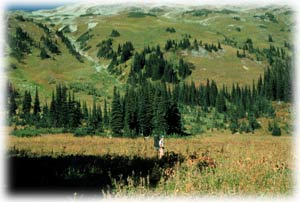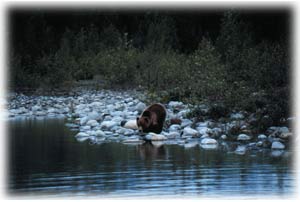|
|
|
|
|
|
|
 Southern Chilcotin-Spruce Lake Wilderness is a spectacular area, featuring stunning vistas of winding rivers, glistening lakes and rolling alpine-covered mountains. The 71,000 ha (175,500 acres) wilderness park is located in a unique region of British Columbia, where coastal wet ecosystems meet dry interior ecosystems, creating an unusual and interesting mix of species. Southern Chilcotin-Spruce Lake Wilderness is a spectacular area, featuring stunning vistas of winding rivers, glistening lakes and rolling alpine-covered mountains. The 71,000 ha (175,500 acres) wilderness park is located in a unique region of British Columbia, where coastal wet ecosystems meet dry interior ecosystems, creating an unusual and interesting mix of species.
Additionally, the newly protected Southern Chilcotin Park links together with adjacent Big Creek Chilcotin Park to create a 140,000 hectare (346,000 acre) wilderness expanse. This large protected stretch of the Chilcotin Mountains will now continue to provide habitat for a variety of plant and wildlife species, many of which are becoming increasingly threatened as southern British Columbia's wilderness disappears.
Visitors to South Chilcotin-Spruce Lake Wilderness will have an unparalleled experience exploring true, untouched wilderness. Backpackers of all skill levels will enjoy the opportunity to follow extensive trails through open valleys and lush, flower filled meadows, past pristine lakes and into high, mountain passes while visiting this beautiful park.
|

Main trailheads for the South Chilcotin-Spruce Lake Wilderness area are only 300 km (185 mi) northeast of Vancouver, or four hours (200 km/ 120 mi) from Whistler, by way of the Hurley Forest Service Road. This backcountry road is open only during the summer season.
Alternatively, the area is only 2 hours, or 80 km (50 mi), from the town of Lillooet, which can be reached by travelling north on Highway 99 or Highway 1.
The South Chilcotin-Spruce Lake Wilderness map had not been distributed at the time of this publication. It will be posted as soon as it is avilable - EDITOR
|
|
"Southern Chilcotin-Spruce Lake Wilderness is a spectacular area, featuring stunning vistas of winding rivers, glistening lakes and rolling mountains."
|

The Spruce Lake area of the Southern Chilcotin Wilderness offers high quality outdoor recreation activity. The gentle rolling alpine of this pristine wild area provides for quality hiking and backpacking, horseback riding, cross-country skiing, and mountain biking.
The Southern Chilcotin-Spruce Lake area contains seven watersheds (Relay, Tyaughton, Gun, Taylor, Leckie, Slim and Upper Nichols Creek), connected by an extensive system of trails.
Sapphire lakes are scattered throughout these watersheds, and surrounded by high peaks. Four lakes, Spruce, Warner, Hummingbird and Trigger are well known for their excellent trout fishing, and make preferred destinations for backcountry hikes. Fishers are reminded that they require a valid fishing licence in order to angle in British Columbia.
|
|
"Sapphire lakes are scattered throughout these watersheds, and surrounded by towering peaks."
|

 The Southern Chilcotin-Spruce Lake area is located in the lee of the Coast Mountain range, making it somewhat drier than areas to the west. The generally gentle rolling mountain terrain of this wilderness area supports high quality wildlife habitat, and significant populations of grizzly and black bears. As well, deer, lynx, wolverine, bobcats, beavers, wolves, mountain goats and California bighorn sheep are all found in the Southern Chilcotins. The most notable birds found in the area include peregrine falcons, ospreys, eagles, hawks, loons and ptarmigan. The Southern Chilcotin-Spruce Lake area is located in the lee of the Coast Mountain range, making it somewhat drier than areas to the west. The generally gentle rolling mountain terrain of this wilderness area supports high quality wildlife habitat, and significant populations of grizzly and black bears. As well, deer, lynx, wolverine, bobcats, beavers, wolves, mountain goats and California bighorn sheep are all found in the Southern Chilcotins. The most notable birds found in the area include peregrine falcons, ospreys, eagles, hawks, loons and ptarmigan.
The valley bottoms of the Southern Chilcotin-Spruces Lake region are home to extensive old growth spruce and pine forests, especially in Bonanza Basin and the Leckie watershed. There are significant mid-elevation grasslands in the area as well, where small groves of aspen are interspersed with stunning wildflower meadows. More than 125 species of wildflowers are known to bloom in the beautiful South Chilcotin Mountains.
"The generally gentle nature of the wilderness area creates ideal wildlife habitat, and significant populations of grizzly and black bears, black tailed deer, lynx, wolverine, bobcats, beavers, wolves, mountain goats and California bighorn sheep are all found in the Southern Chilcotins."
|

The preservation of the Southern Chilcotin-Spruce Lake Wilderness has been a long and difficult process. It began in 1937 when the Vancouver Natural History Society first proposed a provincial park for the region. No further action was undertaken until 1975 though, when the government initiated a Chilcotin Park study. As a result of that study, a recommendation was made to establish a Class A Park or Wilderness area for the headwaters of Tyaughton, Relay and Big Creek, encompassing Spruce Lake and Eldorado Basin to the east.
In 1979 this recommendation had still not been acted on. Rather, logging and mineral exploration in the area was on the increase. Consequently, fourteen local outdoor groups joined together to form The Southern Chilcotin Mountains Wilderness Society. The Society greatly intensified the campaign to achieve protection of the area for many years. However, it met with frustration as the Spruce Lake Integrated Management Plan undertaken by the Government in the early 1980s essentially promoted resource extraction at the expense of wilderness values.
Further setbacks were encountered throughout the 1980s, as logging was initiated in several of the area's valleys. Fortunately, in 1990 the government finally imposed a moratorium on further forestry, in order to allow for a decision to be made on park status. A Protected Areas Strategy study was undertaken for the area and a number of landuse planning tables commenced. Most notably the northern half of the proposed park fell within the Williams Lake Forest District and became part of the Cariboo-Chilcotin Commission on Resources and the Environment (CORE) negotiations.
At the completion of this CORE plan, Big Creek South Chilcotin Provincial Park was created, but it was only one-third the size of the park initially proposed for the area. The southern portion (within the Lillooet Forest District) became a central issue in the Lillooet Land and Resource Management Plan. This LRMP spanned over five years. In 2001, just prior to a provincial election, Government declared the 71,000 ha (175,500 acres) of the Southern Chilcotin/Spruce Lake area a protected area. After almost 70 years this special part of BC had been preserved, not only protecting rich biodiversity and high conservation values, but also finally bringing closure to one of British Columbia's longest-running wilderness issues.
|
|
Return to the Chilcotin Region
Become Involved!

|
|

